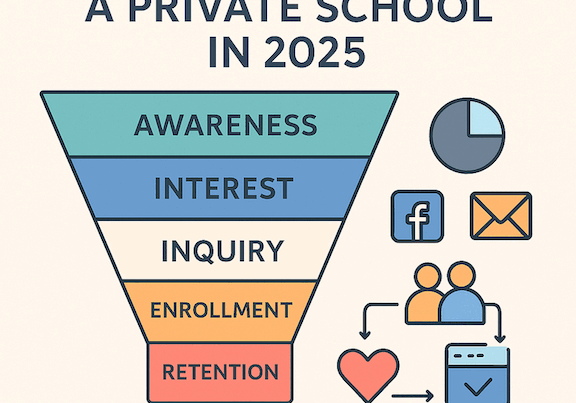In the world of education, most people understand that the admissions process can be extremely competitive. While it’s clear that students need to differentiate themselves from peers to improve their chances at acceptance, some schools are struggling with how to separate themselves from their competition.
Most educational institutions want to attract the best and brightest students. Nonetheless, to do so, they must establish themselves as a worthwhile investment.
Thus, many high schools end up marketing themselves to interested families.
Marketing directly to students can be challenging because it’s not always clear whether a family wants to pursue enrollment. Many admissions committees also struggle to understand why a student has rejected an offer.
One of the most effective ways to tackle this issue is via lead tracking. Lead tracking is a marketing strategy that seeks to attract more clients to a business by analyzing every step in the marketing funnel.
Throughout this article, we will discuss how to track leads. We will explain how to use this strategy to bring more families to a particular school.
What Is Lead Tracking & How Does It Work?
Lead tracking is a marketing strategy in which a business monitors potential leads. One can begin the process by identifying the source of a lead, which may have come from a phone call or website visit. Afterward, one must track said lead throughout the entire buying process.
While the lead progresses towards an eventual purchase, the business must try to bring the lead one step closer to closing the deal. Hence, lead tracking adopts a customer-by-customer approach to selling a product.
Fortunately, this is an especially useful strategy in the case of education.
School admissions committees understand that families expect a sales pitch to feel personal. Relationship building is, indeed, central to a school’s recruitment process.
However, many admissions officers don’t know how to effectively use those relationships. Ideally, admissions teams should connect with parents as a way to promote the school.
Lead tracking facilitates this process.
Engaging in lead tracking allows an admissions team to gauge where each family is in the admissions process. Admissions teams can use said information to push the family forward to the next step in the process.
If parents are browsing schools, motivate them to fill out an application. If a student received an offer, inspire him or her to accept it.
Using said process can help foster a sense of excitement around a particular school. Eventually, this can increase the volume of applications. Ultimately, it can even cause the school to become more competitive.
Create an “Admissions Map”
Lead tracking is a multi-step process. First, the admissions team must understand the full admissions process from start to finish.
School workers can achieve this understanding via “an admissions map.”
Admissions maps are visual representations of a typical student’s path towards enrollment.
Generally, a student’s first step towards enrollment occurs before ever seeing the campus. Typically, the first step is the “research” step.
Common first step examples include “googling local schools,” or, “asking a friend about good schools.” To garner accurate information on the topic, it is best to ask current families how they found out about the school.
Certain steps will often pertain to the initial contact phase. Meanwhile, the remaining steps tend to concern the application process: school visits, standardized tests, teacher recommendations, and acceptance.
Every school engages in a slightly different process. However, the ultimate goal is to create a map that illustrates every stage of the path towards enrollment.
Identify Your Map’s Weak Spots
We can perhaps consider this step the most difficult one in the process of tracking leads. Indeed, no admissions committee wants to remember the candidates that they have lost.
However, recognizing one’s flaws is the key to improvement.
Throughout this step, members of the admissions department should examine the admissions map. Next, these admissions officers should collect data regarding each point of the map.
What percentage of students lost interest in the school after the initial phone call? How many students begin the admissions process, only to leave their application unfinished?
Answering these questions can help an admissions committee understand if there are any moments in particular when a school tends to lose potential students.
Once the committee isolates these moments, its members can circle those key points on the map. Members of the marketing world refer to these points as “pain points.”
Pain points occur when a potential client finds the buying process too frustrating to continue.
One common pain point in school admissions is the initial email. If a family does not receive a prompt reply, they will rarely reach out to a school on a second occasion.
Thus, it’s essential for admissions officers to send out prompt replies.
Each school should identify the pain points in its unique enrollment process. Only then will admissions committees be able to use this information to attract a higher volume of applications.
Apply Lead Nurturing Principles
Lead tracking in schools is not just about identifying when students lose interest in a particular institution. Lead tracking is also about trying to improve on those critical moments.
Lead nurturing is a strategy that schools can use to maintain the interest of potential clients. That aforementioned strategy involves engaging with families in a way that encourages them to continue through the application process.
Below, we have outlined a few of the most effective ways to use lead nurturing.
Stay in Touch
Staying in touch may sound simple. Nonetheless, maintaining contact with interested families can impact their final enrollment decisions.
Per our previous point, families do not tend to fill out a contact form twice. Many users do not trust contact forms, due to the number of times they did not receive a company reply.
Consequently, it is essential for schools to remember that they only have one shot at a first impression. If potential families reach out, it is the school’s responsibility to generate a prompt reply.
However, the admissions team’s efforts should not stop at email replies. After that initial contact, the school must also follow up with the interested parties. Follow-ups allow admissions officers to create a relationship with the parents.
Hence, if potential parents encounter any problems throughout the application process, they will feel more comfortable communicating those problems to the school.
Marketing Must Be Personal
Most educators know that each student is unique. However, many admissions teams forget to relay this message when it comes to marketing their schools.
Our example of this is a student who loves to do math may not respond well to an email about the school’s poetry award. Similarly, a student who plays baseball may not feel inspired by a pamphlet about the school’s choir.
Admissions officers must be prepared to push each student to feel like their talents would be nurtured in a particular school environment. Consequently, it is essential for admissions teams to do their research.
Do not hesitate to ask a parent about a student’s interests. After acquiring that information, admissions teams can impart the information that is relevant to that student.
Invite an athletic student to attend one of the school’s sporting matches. Encourage a musical student to subscribe to the school band’s YouTube channel.
By personalizing an admissions process, schools can help students and their families to feel more supported.
Personalizing the Impersonal
Ideally, admissions committees would be able to hand-craft every email. Many admissions teams would love to tailor each message to an individual student’s needs.
Unfortunately, however, this is not realistic.
Many schools deal with hundreds, and even thousands, of annual applications. Thus, mass emails are an inevitable part of a school’s marketing process.
List segmentation is a phenomenal way to generate those mass emails in a bit more of a personal way. List segmentation works by creating three or four different email lists. Generally, each email list focuses on one of the school’s programs.
Schools might have one list that focuses on STEM courses. Schools may also have a separate list that focuses on the Humanities.
Based on a student’s interests, his or her parent’s email address may be added to a specific list.
Employing various email lists allows an admissions committee to save precious time. Additionally, this process provides students with the personalized experience that they deserve.
Start Lead Tracking Today
Currently, schools must engage with strategies like lead tracking to remain relevant. Lead conversion also has the power to maintain a school’s status. However, not every school knows how to start.
VujaDay has plenty of experience implementing successful marketing strategies. Our team knows how to support schools as they streamline their admissions processes.
Click here to learn more about how to use lead tracking to improve a particular school.
We would be more than happy to help you increase your application volume. Eventually, we could even help make your school more competitive.




